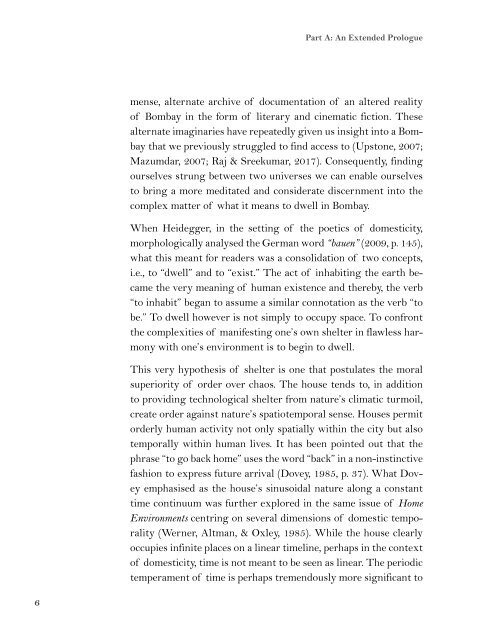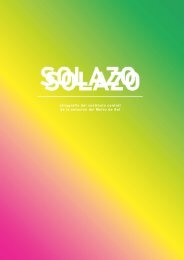Dwelling In (On) Bombay Cinema
Dwelling In (On) Bombay Cinema is an experimental research into the domestic condition of Bombay through a reading of Bombay cinema. It composes of an audio-visual product and the following textual documentation of the investigation methodology. These two entities are intended to be archived together digitally and physically. This work is part of the final assignment (trabajo fin de máster) of the masters programme in architectural communication or MAca (Máster Universitario en Comunicación Arquitectónica ) in the Superior Technical School of Architecture of Madrid (Escuela Técnica Superior de Arquitectura de Madrid) under the Technical University of Madrid (Universidad Politécnica de Madrid). The following document is to accompanied by the digital essay-film available through the following link: https://youtu.be/OO8dxD5Ypos The investigation is authored by Akshid Rajendran. And tutored by Atxu Amann y Alcocer and Samuel Fuentes. January 2019.
Dwelling In (On) Bombay Cinema is an experimental research into the domestic condition of Bombay through a reading of Bombay cinema. It composes of an audio-visual product and the following textual documentation of the investigation methodology. These two entities are intended to be archived together digitally and physically. This work is part of the final assignment (trabajo fin de máster) of the masters programme in architectural communication or MAca (Máster Universitario en Comunicación Arquitectónica ) in the Superior Technical School of Architecture of Madrid (Escuela Técnica Superior de
Arquitectura de Madrid) under the Technical University of Madrid (Universidad Politécnica de Madrid).
The following document is to accompanied by the digital essay-film
available through the following link: https://youtu.be/OO8dxD5Ypos
The investigation is authored by Akshid Rajendran.
And tutored by Atxu Amann y Alcocer and Samuel Fuentes.
January 2019.
You also want an ePaper? Increase the reach of your titles
YUMPU automatically turns print PDFs into web optimized ePapers that Google loves.
Part A: An Extended Prologue<br />
mense, alternate archive of documentation of an altered reality<br />
of <strong>Bombay</strong> in the form of literary and cinematic fiction. These<br />
alternate imaginaries have repeatedly given us insight into a <strong>Bombay</strong><br />
that we previously struggled to find access to (Upstone, 2007;<br />
Mazumdar, 2007; Raj & Sreekumar, 2017). Consequently, finding<br />
ourselves strung between two universes we can enable ourselves<br />
to bring a more meditated and considerate discernment into the<br />
complex matter of what it means to dwell in <strong>Bombay</strong>.<br />
When Heidegger, in the setting of the poetics of domesticity,<br />
morphologically analysed the German word “bauen” (2009, p. 145),<br />
what this meant for readers was a consolidation of two concepts,<br />
i.e., to “dwell” and to “exist.” The act of inhabiting the earth became<br />
the very meaning of human existence and thereby, the verb<br />
“to inhabit” began to assume a similar connotation as the verb “to<br />
be.” To dwell however is not simply to occupy space. To confront<br />
the complexities of manifesting one’s own shelter in flawless harmony<br />
with one’s environment is to begin to dwell.<br />
This very hypothesis of shelter is one that postulates the moral<br />
superiority of order over chaos. The house tends to, in addition<br />
to providing technological shelter from nature’s climatic turmoil,<br />
create order against nature’s spatiotemporal sense. Houses permit<br />
orderly human activity not only spatially within the city but also<br />
temporally within human lives. It has been pointed out that the<br />
phrase “to go back home” uses the word “back” in a non-instinctive<br />
fashion to express future arrival (Dovey, 1985, p. 37). What Dovey<br />
emphasised as the house’s sinusoidal nature along a constant<br />
time continuum was further explored in the same issue of Home<br />
Environments centring on several dimensions of domestic temporality<br />
(Werner, Altman, & Oxley, 1985). While the house clearly<br />
occupies infinite places on a linear timeline, perhaps in the context<br />
of domesticity, time is not meant to be seen as linear. The periodic<br />
temperament of time is perhaps tremendously more significant to<br />
6




